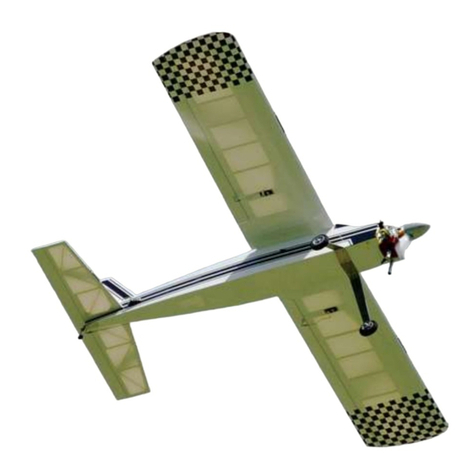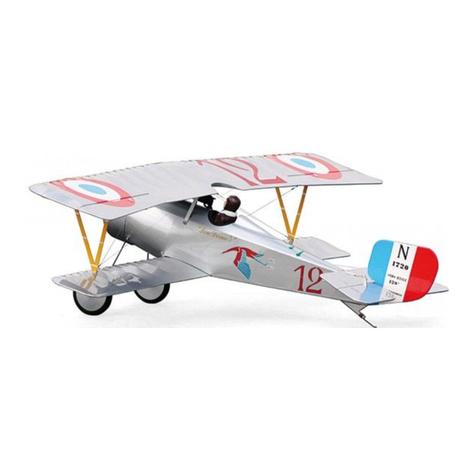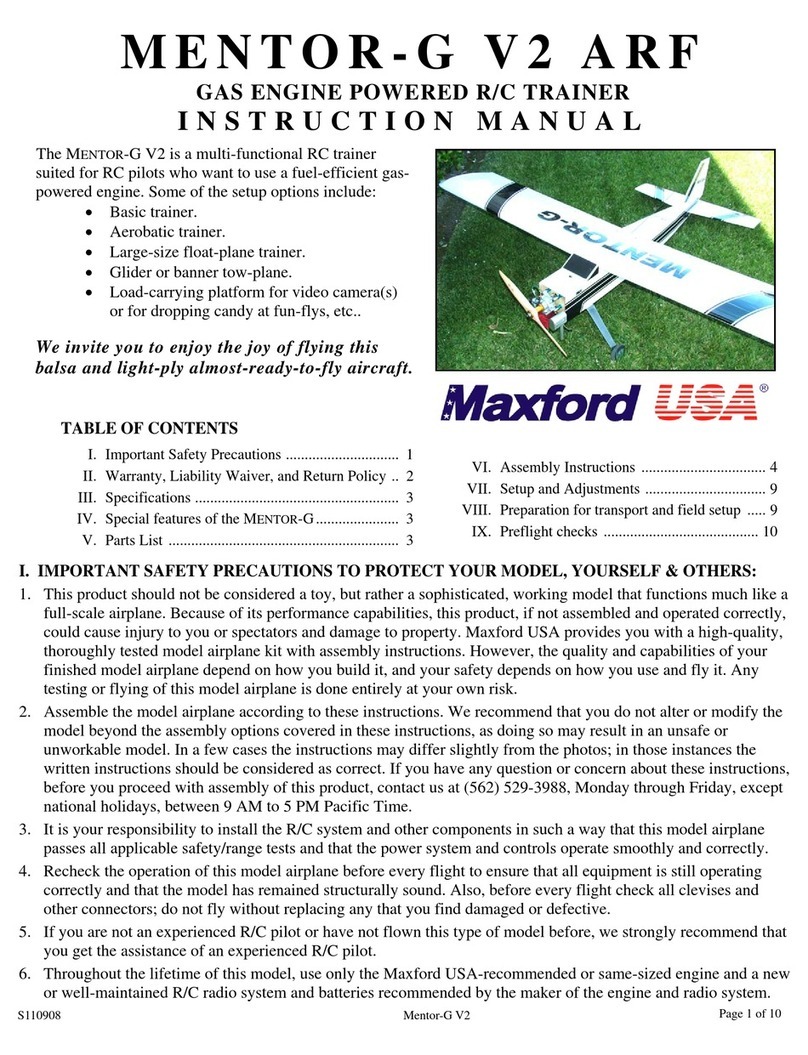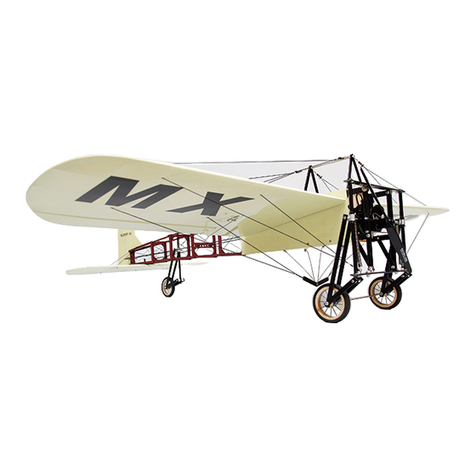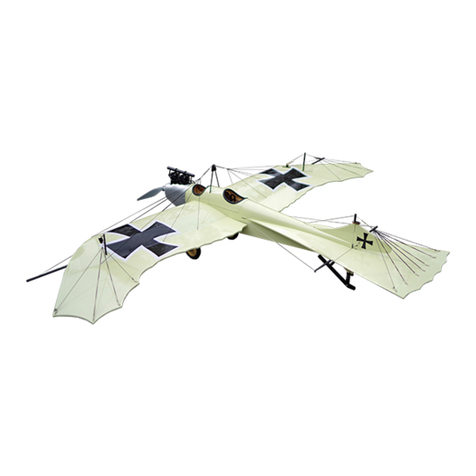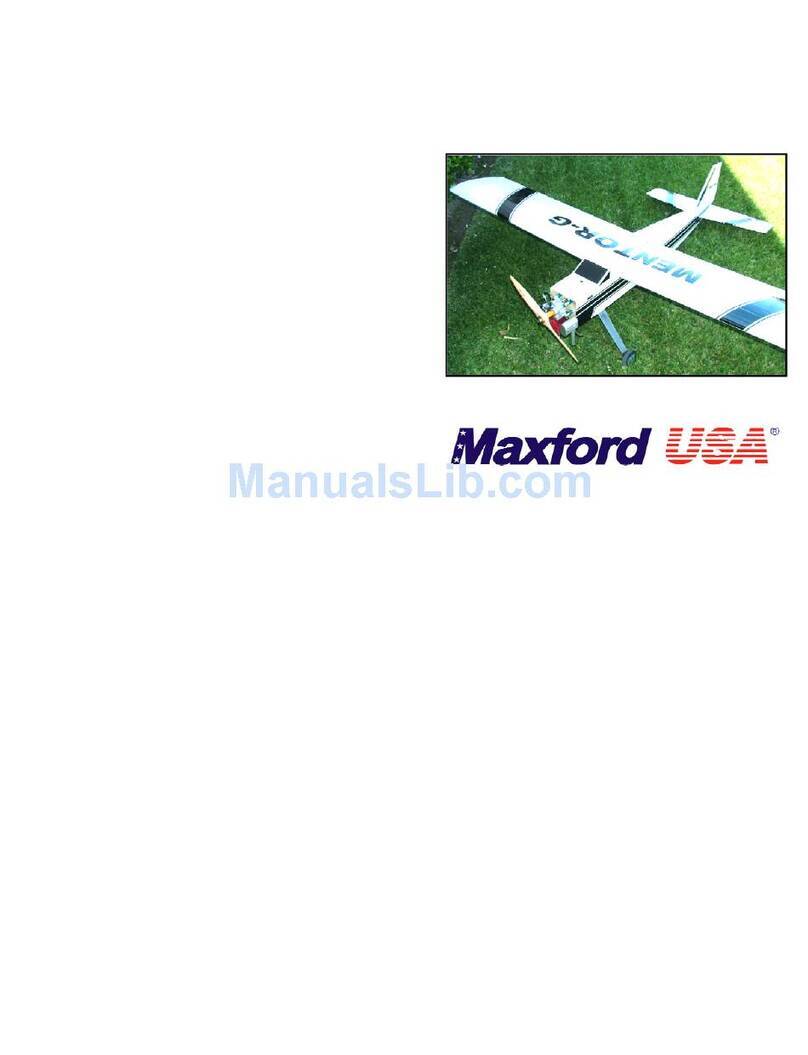
Copyright Maxford USA 2019
5. Preflight checks:
a. If any weight was added
b. Double-check the
c.
Make certain all screws, clevises and other
(Do not attempt to fly with any damaged or frayed
d. Double-check all
e. As with all radio-
controlled model airplanes, this model must pass the radio range ground check
recommended by your radio’s manufacturer or you ma
f. M
ake it a habit to set your transmitter’s throttle control safely to minimum before turning ON your
transmitter and
g. Setup and operate your radio
instructions and follow the guidelines offered by the Academy of Model Aeronautics, your local R/C
club, and concerned manufacturers,
VI. SAFE
TY PRECAUTIONS & ASSEMBLY TIPS
(IMPORTANT – READ
1.
This product should not be considered a toy, but rather a sophisticated, working model that functions
much like a full-
scale airplane. Because of its performance capabilities, this product, if not assembled and
operated correctly, could cause injury to you
provides you with a high-
quality, thoroughly tested model airplane kit
instructions. However, the quality and capabilities of your finished model airplane depend on how you
assemble it, and your safety depends on how you use and fly it. Any testing or flying of this model airplane
is done entirely at your own risk.
2. Assemble this
model airplane according to these
model beyond any assembly and
result in an unsafe or unworkable model. If the instructions differ from the photos, the written
instructions should be considered
correct. If you have any question or
before you proceed with assembly of this product, contact your dealer or speak to a Maxford USA
customer service representative at
9 AM to 5 PM Pacific Time).
3. While this kit has been flight-
tested to meet or exceed our rigid performance and reliability standards in
normal use, if you elect to attempt
larger power system than specified, you
taking any and all necessary steps to reinforce the high
more suitable for such increased stresses.
4.
Throughout the lifetime of this model, use o
or well-maintained radio-
5.
Before you begin assembly of this model airplane, study the instructions and test
you fully understand the
instructions and that no parts are missing, damaged or unsatisfactory.
parts may differ slightly from those pictured
differences between the factory, our warehouse and your home or workshop
slight adjustments to
and alignment. W
e recommend you contact us before attempting any such adjustment.
6.
It is your responsibility to install the receiver and
model passes all applicable safety/range tests and that the power system and controls operate correctly.
7.
Recheck the operation of this model before
and that the model remains
D
o not fly without replacing any that you find damaged or worn.
Page 4 of 13
to adjust the CG, ensure it
secure attachment of your propellers
Make certain all screws, clevises and other
mechanical and electrical
(Do not attempt to fly with any damaged or frayed
electrical or mechanical connection.)
the amounts of control throws.
controlled model airplanes, this model must pass the radio range ground check
recommended by your radio’s manufacturer or you ma
y not fly safely.
ake it a habit to set your transmitter’s throttle control safely to minimum before turning ON your
starting your engines or connecting your Lipo
control and power systems according to their
instructions and follow the guidelines offered by the Academy of Model Aeronautics, your local R/C
club, and concerned manufacturers,
who
all wish to help ensure your safe enjoyment of this hobby.
TY PRECAUTIONS & ASSEMBLY TIPS
CAREFULLY BEFORE YOU
This product should not be considered a toy, but rather a sophisticated, working model that functions
scale airplane. Because of its performance capabilities, this product, if not assembled and
operated correctly, could cause injury to you
or to
spectators and damage to property. Maxford USA
quality, thoroughly tested model airplane kit
and
instructions. However, the quality and capabilities of your finished model airplane depend on how you
assemble it, and your safety depends on how you use and fly it. Any testing or flying of this model airplane
model airplane according to these
written/photo instructions.
Do not alter or modify the
power-
system options covered in these instructions
result in an unsafe or unworkable model. If the instructions differ from the photos, the written
correct. If you have any question or
concern about the instructions,
before you proceed with assembly of this product, contact your dealer or speak to a Maxford USA
customer service representative at
562-529-3988
(Monday through Friday, except national holidays,
tested to meet or exceed our rigid performance and reliability standards in
-stress flying, such as racing or
aerobatics, or if you install a
larger power system than specified, you
(the buyer or user of this product) are solely responsible for
taking any and all necessary steps to reinforce the high
-
stress points and/or substitute hardware that is
more suitable for such increased stresses.
Throughout the lifetime of this model, use o
nly the Maxford USA-
recommended power system and a new
with fully charged batteries.
Before you begin assembly of this model airplane, study the instructions and test
-
instructions and that no parts are missing, damaged or unsatisfactory.
parts may differ slightly from those pictured
in this manual. Due to t
emperature and/or humidity
differences between the factory, our warehouse and your home or workshop
,
and/or to
some mounting surfaces to ensure proper
e recommend you contact us before attempting any such adjustment.
It is your responsibility to install the receiver and
to
connect the R/C components in such a way that this
model passes all applicable safety/range tests and that the power system and controls operate correctly.
Recheck the operation of this model before
every flight to ensure all equipment is still operating correctly
; also
check all electrical, control and structural connections
o not fly without replacing any that you find damaged or worn.
RS190529
.
electrical or mechanical connection.)
controlled model airplanes, this model must pass the radio range ground check
ake it a habit to set your transmitter’s throttle control safely to minimum before turning ON your
.
instructions and follow the guidelines offered by the Academy of Model Aeronautics, your local R/C
all wish to help ensure your safe enjoyment of this hobby.
)
This product should not be considered a toy, but rather a sophisticated, working model that functions
scale airplane. Because of its performance capabilities, this product, if not assembled and
spectators and damage to property. Maxford USA
assembly
instructions. However, the quality and capabilities of your finished model airplane depend on how you
assemble it, and your safety depends on how you use and fly it. Any testing or flying of this model airplane
Do not alter or modify the
system options covered in these instructions
; doing so may
result in an unsafe or unworkable model. If the instructions differ from the photos, the written
concern about the instructions,
before you proceed with assembly of this product, contact your dealer or speak to a Maxford USA
(Monday through Friday, except national holidays,
tested to meet or exceed our rigid performance and reliability standards in
aerobatics, or if you install a
(the buyer or user of this product) are solely responsible for
stress points and/or substitute hardware that is
recommended power system and a new
instructions and that no parts are missing, damaged or unsatisfactory.
Some
emperature and/or humidity
be some need for
some mounting surfaces to ensure proper
installation
e recommend you contact us before attempting any such adjustment.
connect the R/C components in such a way that this
model passes all applicable safety/range tests and that the power system and controls operate correctly.
every flight to ensure all equipment is still operating correctly
check all electrical, control and structural connections
.

